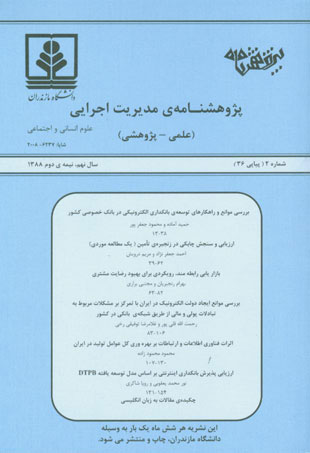Mounetary and Non-Monetary Factors in Fluencing Inflation In Iran(1958-2004)
Author(s):
Abstract:
Since inflation has been regarded as a serious economic problem, many economists studied it and each economic school, according to its predefined assumptions, provided theories and has ultimately explained the inflation phenomenon. The monetarists believed that the growth of (the amount of) money in circulation faster than the production, would lead to inflation. The structuralists blame the basic disequilibrium’s in the economy as the main cause of inflation. The advocates of cost-push and demand-pull inflation respectively blame the increase of costs of production and the gap between aggregate supply and demand as the main cause of the inflation. The psychological theory of inflation emphasizes the effects of inflationary expectations on the inflationand some consider the import inflation as the main cause for increasing of domestic general price level. However, the inflation process in its different forms and in different countries has special complexities. Many research articles have studied the formation trend and determinants of inflation in Iran, and each of them introduced a different set of factors affecting the inflation. Most of theseresearches using single-equation models and linear regressions, stressed the monetary nature of inflation in Iran, and introduced the expansion of the stock of money as the main cause of inflation. In this article, we tried to study the factors affecting the inflation, and their contribution in inflation formation. Therefore, using a simultaneous system of equations, the contribution of money stock growth and exchange rate, as monetary factors affecting on inflation, was studied to include the relations the variables, and explanatory equations of each variable was estimated. The problems arise from economic disequilibrium’s also treated as factors affecting the inflation. Thus, the relative gap of production, measured by Hedrick- Prescott filter, shows the effects of economic structural disequilibrium on inflation formation. Inflationary expectations and import inflation have positive effects on the general price level. This research,covering the period 1959-2000, shows that although the inflation in Iran is not a pure monetary phenomenon and factors like the import inflation, structural economic problems and inflationary expectations have had positive effects on its formation, the growth of money stock (58.32%) has the most important and largest contribution in the inflation in Iran. Other factors according to their relative importance and share in inflation formation are: import inflation (22.6%), inflationary expectations (7.3%), production gap (5.6%) and the growth of exchange rate (6.2%).
Language:
Persian
Published:
Journal of Humanities and Social Sciences, Volume:5 Issue: 19, 2007
Page:
33
magiran.com/p394846
دانلود و مطالعه متن این مقاله با یکی از روشهای زیر امکان پذیر است:
اشتراک شخصی
با عضویت و پرداخت آنلاین حق اشتراک یکساله به مبلغ 1,390,000ريال میتوانید 70 عنوان مطلب دانلود کنید!
اشتراک سازمانی
به کتابخانه دانشگاه یا محل کار خود پیشنهاد کنید تا اشتراک سازمانی این پایگاه را برای دسترسی نامحدود همه کاربران به متن مطالب تهیه نمایند!
توجه!
- حق عضویت دریافتی صرف حمایت از نشریات عضو و نگهداری، تکمیل و توسعه مگیران میشود.
- پرداخت حق اشتراک و دانلود مقالات اجازه بازنشر آن در سایر رسانههای چاپی و دیجیتال را به کاربر نمیدهد.
In order to view content subscription is required
Personal subscription
Subscribe magiran.com for 70 € euros via PayPal and download 70 articles during a year.
Organization subscription
Please contact us to subscribe your university or library for unlimited access!



